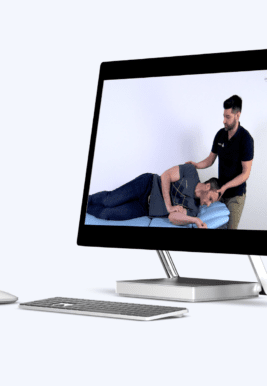Learn
Head Impulse Test | Peripheral Vestibular Dysfunction Assessment
Molnar et al. (2014) describe that most patients with sustained vertigo suffer from vestibular neuronitis, although a few patients (especially elderly patients with cardiovascular risk factors) are having a stroke or other serious disease in the cerebellum and brainstem. A helpful bedside maneuver to help distinguish central and peripheral causes is the head impulse test. Dros et al. (2010) performed an analysis of 7 studies and found a pooled sensitivity of 63% and a pooled specificity of 93%. For this reason, the Head Impulse Test has a high clinical value to confirm peripheral vestibular dysfunction in patients with prolonged dizziness.
Before you start make sure that you only do this test in a patient with prolonged vertigo as brief episodes more likely indicate BPPV and should be tested with the Dix-Hallpike maneuver that you can watch with a click in the top right corner.
To perform the test the examiner sits in front of the patient and places a hand on each side of the patient’s head. The patient is instructed to focus on the examiner’s nose and the examiner focuses on the patient’s eyes. The patient should keep their eyes open even if vertigo symptoms worsen. Now the examiner quickly turns the patient’s head towards the side to be tested while watching the patient’s eyes. Afterward, the head is slowly returned to neutral and the process is repeated several times.
LEARN TO TREAT THE MOST COMMON CAUSE OF VERTIGO IN THIS FREE MINI-VIDEO-SERIES

References
Like what you’re learning?
BUY THE FULL PHYSIOTUTORS ASSESSMENT BOOK
- 600+ Pages e-Book
- Interactive Content (Direct Video Demonstration, PubMed articles)
- Statistical Values for all Special Tests from the latest research
- Available in 🇬🇧 🇩🇪 🇫🇷 🇪🇸 🇮🇹 🇵🇹 🇹🇷
- And much more!








